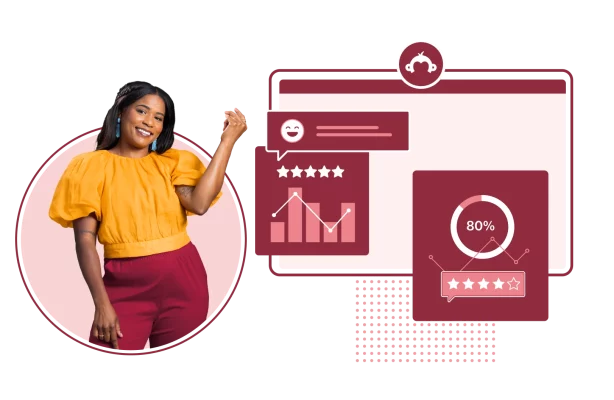What is an ideal customer profile (ICP), and how to define yours

Ever wondered why some companies connect so naturally with their best customers? It starts with an ideal customer profile (ICP) — a clear description of who benefits most from your work. Like a compass for your business, this profile aligns your product development, sales, and every team in between around a shared understanding of your most valuable customers. Let's explore how getting this description right drives sustainable growth.
What is an ideal customer profile (ICP)?
An ideal customer profile (ICP) describes the customers who create mutual value: they get exceptional results from your offering, while providing valuable returns through referrals, feedback, positive reviews, and repeat business.
Related article: What is customer profiling?
Why is an ideal customer profile important?
Your ICP guides every customer interaction — from how you market and sell to how you deliver and support your product. When your team knows exactly who they're serving, they can find the right prospects more easily and turn them into long-term customers who truly value your offering.
Ideal customer profile vs. buyer persona—What’s the difference?
While the terms "ideal customer profile" and "buyer persona" are often used interchangeably, they serve different purposes in your marketing strategy.
What’s a buyer persona?
A buyer persona is a detailed description of an individual who represents your target audience. Unlike the ICP, which focuses on the ideal company or customer segment, a buyer persona zooms in on the individual level. A buyer persona will often include very specific demographic details, behavioral traits, motivations, and goals.
What's the purpose of a buyer persona?
The main purpose of a buyer persona is to humanize the marketing and sales efforts, providing a clear picture of who the customer is, what they value, and how they make purchasing decisions. This allows businesses to craft more personalized and effective marketing messages.
Differences between ICP and buyer persona
ICPs and buyer personas work together but serve different purposes. Your ICP identifies which type of customer brings the most value to your business. Buyer personas then zoom in on the specific needs, behaviors, and preferences of the individuals who make decisions within those ideal customer companies.
Think of it this way: your ICP tells you which companies to target, while buyer personas help you understand how to connect with the people inside those companies.
Who uses an ICP?

Virtually any business will benefit from identifying and understanding its ideal customers. However, having a clear ICP is especially critical for businesses that operate in niche markets or have a limited budget, as it allows them to focus their resources where they are most likely to see a return on investment (ROI).
Marketing and Sales
Knowing your ideal customer can help marketing teams develop compelling and highly-targeted messaging to attract the right customers. When new leads come in, having a solid understanding of your ideal customer can help your marketing team quickly decide if a lead is likely to buy from you and only route highly qualified leads to your sales team for follow up. As a result, both marketing and sales can spend their time and resources focusing on prospects that are a great match for what your business can do and what your prospect hopes to achieve.
Customer Success
Clarifying your ideal customer can also help you avoid going after clients that won’t be valuable to your business long-term. For example, attracting a customer whose needs exceed your product’s capabilities will likely cost you in the long run. While you may be able to close the deal with a lower-fit prospect, these customers can quickly drain your customer support resources and take time away from customers who are a better match.
Product Development
Finally, defining your ICP can help you more effectively steer your product roadmap. When you deeply understand your ideal customer, you can continuously improve and expand your product offering to deliver more value, capture more wallet share, and improve customer satisfaction and retention metrics.
Benefits of identifying your ICP
Identifying your ICP can dramatically streamline your marketing and sales processes. The following are several key advantages of identifying your ideal customers:
Build a more powerful brand
Understanding your ICP can help you identify what matters most to your target audience. When you understand your ideal customers' pain points, interests, and preferences, you can produce solutions and messaging that resonate with them. Over time, prospects will begin to look to your brand as a trusted resource for valuable solutions and insights.
Improve your marketing efficiency and ROI
Marketing budgets deliver better results when you know exactly who benefits most from your solution — and who's willing to pay for that value. With this clarity, you can build campaigns that speak directly to your best prospects' needs. Your marketing spend will work harder because every ad, email, and piece of content will resonate with the right audiences.
Optimize your product roadmap
An ICP guides product development and service offerings by clarifying who you are serving and what they truly need. This makes it possible for product teams to prioritize the innovations and improvements that will make the most impact and set the business apart from competitors. When your product roadmap is built around your ICP, you can position your product as not just another option in the market, but rather a tailored solution that speaks directly to your audience's needs.
Enhance customer satisfaction and loyalty
When you deeply understand your ideal customers' needs, you can shape every experience to match what they value most. These customers become your strongest advocates—they stay longer, buy more, and recommend you to others because you consistently deliver exactly what they're looking for.
How to create an ideal customer profile
Creating an ICP requires thoroughly understanding your current and potential customer base. Here’s how you can develop an effective ICP.
Conduct market research
Market research is crucial for understanding the broader market landscape, including competitors, industry trends, and potential customer segments. Your goal is to understand what it is that you do best: what is the key problem you are solving within the market? Who can benefit most from your solution?
For example, if your company offers website-building software, you might consider if your solution is best suited for individuals building a single website for themselves or an agency building hundreds or even thousands of websites on behalf of their clients. You’d then look at what other software in the web building space is doing and who their solutions are best suited for. This can help you narrow down your niche and competitive differentiation.
Analyze your existing customer data
It’s a great idea to take a look at your existing customer data to pinpoint the types of customers that see the most success. Which customers are most loyal to your business? Which ones deliver the highest lifetime value (LTV)? Who are your biggest brand advocates?
One way to capture this information is by reviewing your customer feedback metrics, including your Net Promoter Score® or Customer Satisfaction Scores (CSAT), as well as qualitative insights from product reviews or product feedback surveys. These can help you understand which types of customers consistently have the highest satisfaction scores and are the most vocal in sharing positive feedback about your brand and products.
From there, you can identify the commonalities between all of your current best and happiest customers—a fantastic starting point for your ICP. You can drill down into characteristics like:
- Revenue or company size Is your product or service best for local small-to-medium businesses (SMBs), fast-growing VC-funded startups, or multinational enterprises?
- Budget: What are your best customers willing to spend? And are you getting the ROI you need?
- Industry: Are there specific verticals that are especially successful with your solution? Are there verticals that are less successful?
- Geography: In what regions are your most loyal customers based?
Develop customer personas
Based on your analysis, you can now start to create detailed customer personas that represent your ideal or “good-fit” customers. These customer personas will help you tailor your marketing, sales, and product development efforts.
Prioritize and segment
Not all customers are created equal. You might have identified several different customer profiles that could be a great match for your business. However, with limited time and budget, it often isn’t possible to go after every segment at once. You’ll need to prioritize your customer segments based on their value to your business and focus your efforts accordingly.
Close the feedback loop, collaborate, and iterate
Finally, keep in mind that an ICP is not set in stone. Your ideal customer profile can and should evolve as your business grows and as you gather more data. Be sure to collaborate across teams and regularly update your ICP based on customer feedback and evolving trends in your market.
Use surveys to conduct market research and discover your ideal customer profile
Ideal customer profiles are invaluable to teams across your organization. Profiles align teams to your ideal customer’s needs, allowing your company to create customer-centered solutions.
Start conducting market research with our Market Research Survey Template to gain insight into the market landscape and identify your company’s ideal customer.
To dive deeper into creating effective marketing strategies, learn about SurveyMonkey for Marketing.
Net Promoter, Net Promoter Score, and NPS are trademarks of Satmetrix Systems, Inc., Bain & Company, Inc., and Fred Reichheld.
Discover more resources

Understand Your Target Market To Fuel Explosive Brand Growth
Brand marketing managers can use this toolkit to understand your target audience, grow your brand, and prove ROI.

See SurveyMonkey In Action: Event Registration And Feedback

Hornblower Enhances Global Customer Experiences
Discover how Hornblower uses SurveyMonkey and powerful AI to make the most of NPS data, collect customer insights, and improve customer experiences.

Marketing Trends: 3 Strategies To Stay Relevant And Ready For What's Next
New SurveyMonkey research reveals critical insights on the state of marketing. Discover marketing trends to fuel your strategies and stay relevant.